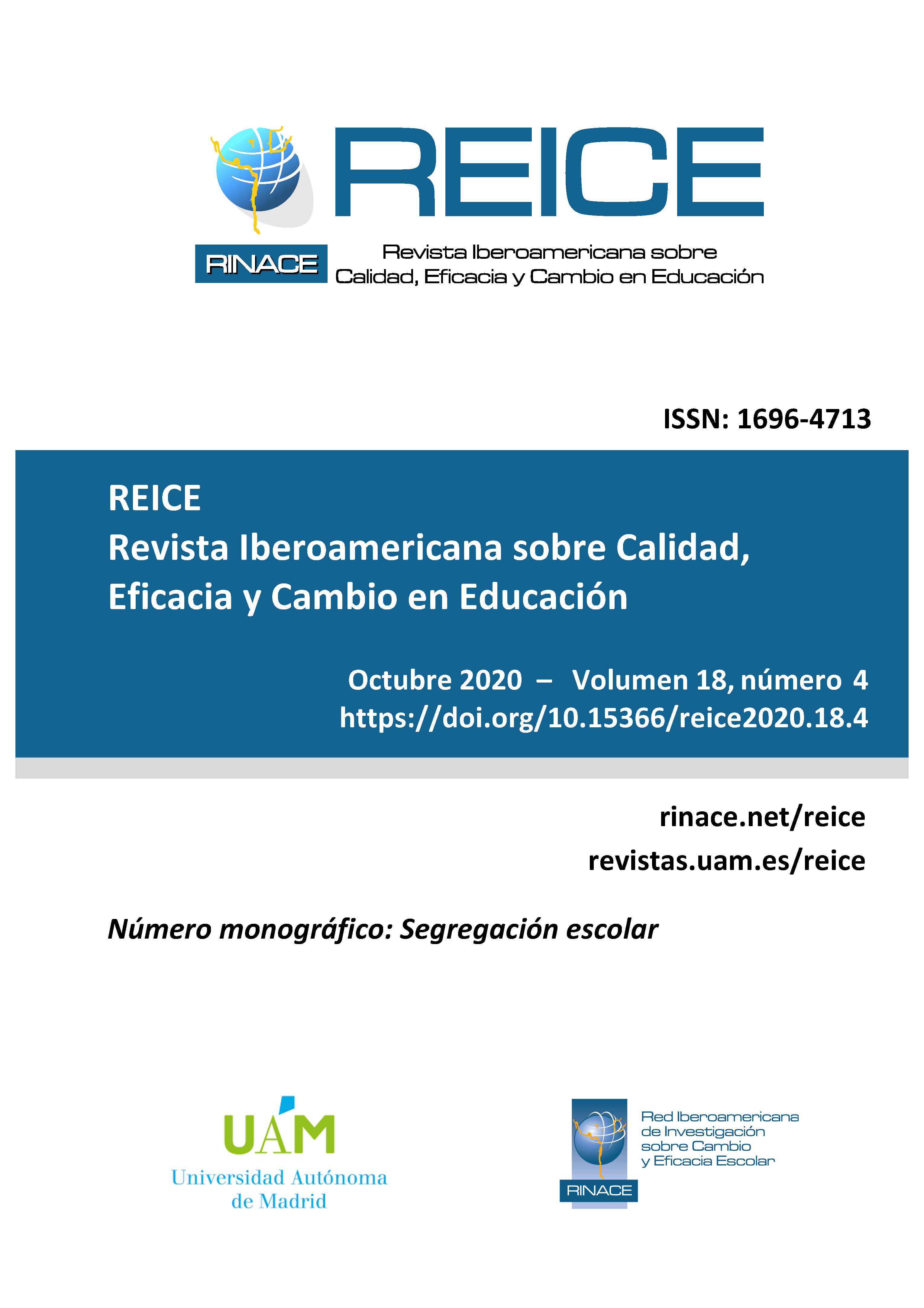Estudio Longitudinal de la Segregación Escolar por Nivel Socioeconómico en Reino Unido
Palabras clave:
Segregación por nivel socioeconómico entre escuelas, PISA, Países del Reino Unido, Agrupación por nivel socioeconómico, Igualdad de oportunidades
Esta obra está bajo una licencia internacional Creative Commons Atribución-NoComercial-SinDerivadas 4.0.
Resumen
El objetivo de este estudio es comprender el comportamiento de la segregación escolar por nivel socioeconómico. Para ello se analizan todos los datos del Reino Unido en la Evaluación PISA desde el año 2000 a 2015 y se estima el índice de Gorard, el índice de Disimilitud y el índice de Aislamiento. El análisis realizado ha demostrado que la segregación entre las escuelas ha disminuido entre 2000 y 2015, y que la segregación del 25% de los estudiantes más pobres se ha mantenido relativamente estática en el Reino Unido desde el año 2006. Las escuelas de Inglaterra están muy segregadas en comparación con Gales, Escocia e Irlanda del Norte. Los niveles de segregación del 10% de estudiantes más pobres han disminuido en las escuelas públicas, mientras hay un fuerte aumento en las privadas. El nivel de aislamiento de los estudiantes desfavorecidos es menor en las escuelas públicas que privadas. Los resultados han demostrado que la tendencia de la segregación escolar por nivel socioeconómico utilizando los datos PISA es coherente con la tendencia de segregación analizada utilizando datos nacionales de las escuelas públicas. Este hallazgo conlleva implicaciones de investigación para un análisis detallado de las tendencias nacionales de segregación escolar, incluidos los datos de estudiantes de escuelas privadas.
Descargas
Citas
Bartholo, T. & Costa, M. (2014). Turnos e segregação escolar: Discutindo as desigualdades intraescolares. Cadernos de Pesquisa, 44(153), 670-692. https://doi.org/10.1590/198053142771
Billings, S., Deming, D., & Ross, S. (2016). Returns to education: The causal effects of education on earnings, health and smoking. Economics Research Center-University of Chicago.
Boliver, V. (2011). Expansion, differentiation, and the persistence of social class inequalities in British higher education. Higher Education, 61(3), 229-242. https://doi.org/10.1007/s10734-010-9374-y
Borooah, V. & Knox, C. (2015). Segregation, inequality, and educational performance in Northern Ireland: Problems and solutions. International Journal of Educational Development, 40, 196-206. https://doi.org/10.1016/j.ijedudev.2014.09.002
Cavalcanti, T., Guimaraes, J., & Sampaio, B. (2010). Barriers to skill acquisition in Brazil: Public and private school student’s performance in a public university entrance exam. The Quarterly Review of Economics and Finance,50(4), 395-407. https://doi.org/10.1016/j.qref.2010.08.001
Cheng, S. C. & Gorard, S. (2010). Segregation by poverty in secondary schools in England 2006-2009: A research note. Journal of Education Policy, 25(3), 415-418. https://doi.org/10.1080/02680931003699542
Condron, D. (2011). Egalitarianism and educational excellence compatible goals for affluent societies? Educational Researcher, 40, 47-55. https://doi.org/10.3102/0013189X11401021
Condron, D. J. (2013). Affluence, inequality, and educational achievement: A structural analysis of 97 jurisdictions across the globe. Sociological Spectrum, 33(1), 73-97. https://doi.org/10.1080/02732173.2013.732866
Croxford, L. & Raffe, D. (2013). Differentiation and social segregation of UK higher education, 1996-2010. Oxford Review of Education, 39(2), 172-192. https://doi.org/10.1080/03054985.2013.784193
Duncan, O. & Duncan, B. (1955). A methodological analysis of segregation indexes. American Sociological Review, 20, 210-217. https://doi.org/10.2307/2088328
Echenique, F. & Fryer, J. (2007). A measure of segregation based on social interactions. The Quarterly Journal of Economics, CXXII(2), 441-485. https://doi.org/10.1162/qjec.122.2.441
Gorard, S. (2000). Underachievement is still an ugly word: Reconsidering the relative effectiveness of schools in England and Wales. Journal of Education Policy, 15(5), 559-573. https://doi.org/10.1080/026809300750001694
Gorard, S. (2007). What does an index of school segregation measure? A commentary on Allen and Vignoles, Oxford Review of Education, 33, 5, 669-677. https://doi.org/10.1080/03054980701451140
Gorard, S. (2015). The complex determinants of school intake characteristics, England 1989 to 2014, Cambridge Journal of Education, 46, 1, 131-146. https://doi.org/10.1080/0142569980190306
Gorard, S. & Fitz, J. (1998). The more things change... The missing impact of marketisation? British Journal of Sociology of Education, 19(3), 365-376. https://doi.org/10.1080/026715200402452
Gorard, S. & Fitz, J. (2000a). Investigating the determinants of segregation between schools. Research Papers in Education, 15(2), 115-132. https://doi.org/10.1177/0895904800014003004
Gorard, S. & Fitz, J. (2000b). Markets and stratification: A view from England and Wales. Educational Policy,14(3), 405-428. https://doi.org/10.1177/0895904800014003004
Gorard, S., Smith, E., May, H., Thomas, L., Adnett, N., & Slack, K. (2006). Review of widening participation research: Addressing the barriers to participation in higher education. https://vtechworks.lib.vt.edu/bitstream/handle/10919/97805/BarriersHigEducEngland.pdf?sequence=1
Gorard, S., Siddiqui, N., & See, B. H. (2019). The difficulties of judging what difference the pupil premium has made to school intakes and outcomes in England. Research Papers in Education, https://doi.org/10.1080/02671522.2019.1677759
Harris, D. & Williams, J. (2012). The Association of classroom interactions, year group and social class. British Educational Research Journal, 38(3), 373-397. https://doi.org/10.1080/01411926.2010.548547
Knowles, E. & Evans, H. (2012). PISA 2009: How does the social attainment gap in England compare with countries internationally? https://assets.publishing.service.gov.uk/government/uploads/system/uploads/attachment_data/file/198957/DFE-RB206.pdf
Lieberson, S. (1981). An asymmetrical approach to segregation. In C. Peach (Ed.), Ethnic segregation in cities (pp. 61-83). Croom-Helm.
Massey, D. S. & Denton, N. A. (1988). The dimensions of residential segregation. Social Forces, 67(2), 281-315. https://doi.org/10.2307/2579183
Morris, R. (2015). Free schools and disadvantaged intakes. British Educational Research Journal, 41(4), 535-552. https://doi.org/10.1002/berj.3168
Murillo, F. J. & Martínez-Garrido, C. (2018a). Impact of the economic crisis on school segregation in Spain. Revista de Educación, 381, 67-93. https://doi.org/10.4438/1988-592X-RE-2017-381-381
Murillo, F. J. & Martínez-Garrido, C. (2018b). Magnitud de la segregación escolar por nivel socioeconómico en España y sus comunidades autónomas y comparación con los países de la Unión Europea [Magnitude of school segregation by socioeconomic level in Spain and its Autonomous Communities and comparison with the countries of the European Union]. RASE. Revista de Sociología de la Educación, 11(1), 37-58. https://doi.org/10.7203/RASE.11.1.10129
Norwich, B. & Black, A. (2015). The placement of secondary school students with statements of special educational needs in the more diversified system of English secondary schooling. British Journal of Special Education, 42(2), 128-151. https://doi.org/10.1111/1467-8578.12097
Oldfield, E., Hartnett, L., & Bailey, E. (2013). More than an educated guess: Assessing the evidence on faith schools. Theos.
Siddiqui, N. (2017). Socio-economic segregation of disadvantaged children between schools in Pakistan: Comparing the state and private sector. Educational Studies, 43(4), 391-409. https://doi.org/10.1080/03055698.2016.1277139
Strand, S. & Winston, J. (2008). Educational aspirations in inner city schools. Educational Studies 34(4), 249-267. https://doi.org/10.1080/03055690802034021
Taylor, C. & Gorard, S. (2003). Secondary school admissions in London. Institute for Public Policy Research.

